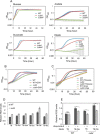A genome-wide screen in Escherichia coli reveals that ubiquinone is a key antioxidant for metabolism of long-chain fatty acids
- PMID: 29042439
- PMCID: PMC5723998
- DOI: 10.1074/jbc.M117.806240
A genome-wide screen in Escherichia coli reveals that ubiquinone is a key antioxidant for metabolism of long-chain fatty acids
Abstract
Long-chain fatty acids (LCFAs) are used as a rich source of metabolic energy by several bacteria including important pathogens. Because LCFAs also induce oxidative stress, which may be detrimental to bacterial growth, it is imperative to understand the strategies employed by bacteria to counteract such stresses. Here, we performed a genetic screen in Escherichia coli on the LCFA, oleate, and compared our results with published genome-wide screens of multiple non-fermentable carbon sources. This large-scale analysis revealed that among components of the aerobic electron transport chain (ETC), only genes involved in the biosynthesis of ubiquinone, an electron carrier in the ETC, are highly required for growth in LCFAs when compared with other carbon sources. Using genetic and biochemical approaches, we show that this increased requirement of ubiquinone is to mitigate elevated levels of reactive oxygen species generated by LCFA degradation. Intriguingly, we find that unlike other ETC components whose requirement for growth is inversely correlated with the energy yield of non-fermentable carbon sources, the requirement of ubiquinone correlates with oxidative stress. Our results therefore suggest that a mechanism in addition to the known electron carrier function of ubiquinone is required to explain its antioxidant role in LCFA metabolism. Importantly, among the various oxidative stress combat players in E. coli, ubiquinone acts as the cell's first line of defense against LCFA-induced oxidative stress. Taken together, our results emphasize that ubiquinone is a key antioxidant during LCFA metabolism and therefore provides a rationale for investigating its role in LCFA-utilizing pathogenic bacteria.
Keywords: bacterial genetics; electron transport; fatty acid metabolism; long chain fatty acids; non-fermentable carbon sources; oxidative stress; quinone; respiratory chain; ubiI; ubiK.
© 2017 by The American Society for Biochemistry and Molecular Biology, Inc.
Conflict of interest statement
The authors declare that they have no conflicts of interest with the contents of this article
Figures






References
-
- McKinney J. D., Höner zu Bentrup K., Muñoz-Elias E. J., Miczak A., Chen B., Chan W. T., Swenson D., Sacchettini J. C., Jacobs W. R. Jr., and Russell D. G. (2000) Persistence of Mycobacterium tuberculosis in macrophages and mice requires the glyoxylate shunt enzyme isocitrate lyase. Nature 406, 735–738 - PubMed
-
- Clark D. P., and Cronan J. E. (2005) Two-carbon compounds and fatty acids as carbon sources. in EcoSal–Escherichia coli and Salmonella: Cellular and Molecular Biology (Curtiss R., III, ed) ASM Press, Washington, D. C. - PubMed
-
- Cronan J. E., and Laporte D. (2006) Tricarboxylic acid cycle and glyoxylate bypass. in EcoSal–Escherichia coli and Salmonella: Cellular and Molecular Biology (Curtiss R., III, ed) ASM Press, Washington, D. C. - PubMed
MeSH terms
Substances
LinkOut - more resources
Full Text Sources
Other Literature Sources
Molecular Biology Databases

